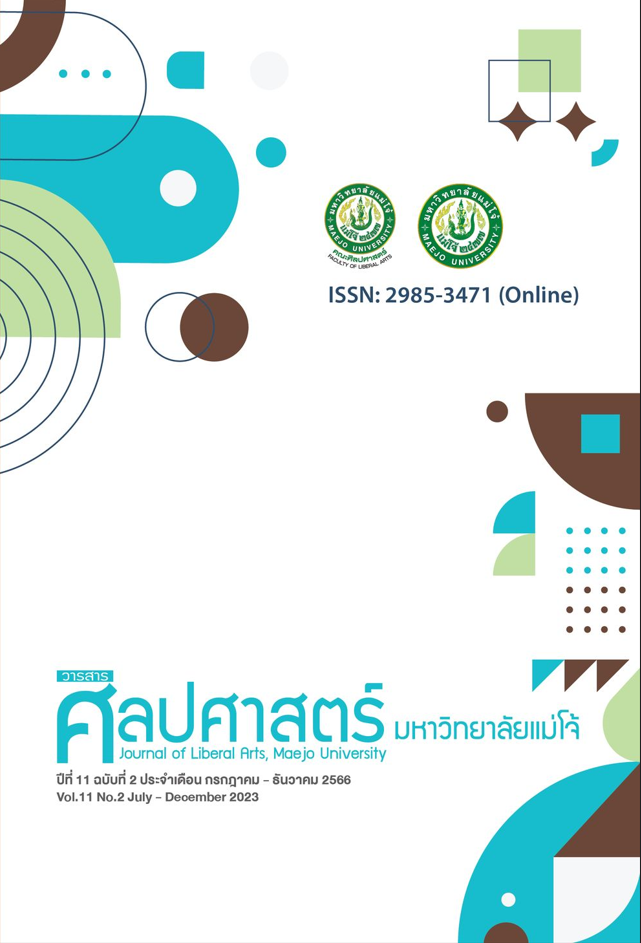ภูมิทัศน์ทางภาษาศาสตร์ของซอยหัวหิน 57: การศึกษาป้ายธุรกิจการค้าเชิงพาณิชย์
Main Article Content
บทคัดย่อ
บทความวิจัยนี้มีวัตถุประสงค์เพื่อศึกษาป้ายธุรกิจการค้าเชิงพาณิชย์ ตามแนวภูมิทัศน์ทางภาษาศาสตร์ (Linguistics Landscape) ในพื้นที่ซอยหัวหิน 57 เก็บข้อมูลจากป้ายธุรกิจจำนวน 79 ป้าย จากธุรกิจจำนวน 58 แห่ง โดยมุ่งศึกษา 1) ประเภทของธุรกิจการค้าเชิงพาณิชย์ 2) รูปแบบภาษา 3) ความสัมพันธ์ระหว่างรูปแบบภาษากับประเภทธุรกิจ และ 4) หน้าที่ของภาษาที่ปรากฏ โดยใช้กรอบแนวคิดของ Landry and Bourhis (1997) ผลการศึกษาประเภทของธุรกิจการค้าเชิงพาณิชย์ จำแนกได้ 17 ประเภท พบธุรกิจร้านนวดมากที่สุด รูปแบบภาษาที่ปรากฏบนป้ายธุรกิจการค้าเชิงพาณิชย์ จำแนกได้ 3 รูปแบบ ป้ายภาษาเดียวพบป้ายภาษาอังกฤษมากที่สุด ป้ายสองภาษาพบป้ายภาษาอังกฤษปนภาษาไทยมากที่สุด และป้ายหลายภาษาพบป้ายภาษาไทย – ภาษาจีน – ภาษาอังกฤษ และป้ายภาษาอังกฤษ - ภาษาจีน – ภาษาไทย จำนวนเท่ากัน ความสัมพันธ์ระหว่างรูปแบบภาษากับประเภทธุรกิจการค้าเชิงพาณิชย์ ป้ายภาษาเดียวพบในธุรกิจร้านอาหารมากที่สุด ป้ายสองภาษาพบในธุรกิจร้านนวดมากที่สุด และป้ายหลายภาษาพบในธุรกิจร้านอาหารมากที่สุด สุดท้ายการศึกษาหน้าที่ของภาษาที่ปรากฏบนป้ายธุรกิจการค้าเชิงพาณิชย์ พบว่าป้ายทำหน้าที่ 3 ประการ คือ หน้าที่การให้ข้อมูล หน้าที่บอกชื่อธุรกิจ และหน้าที่เชิงสัญลักษณ์ ผลการวิจัยดังกล่าวแสดงให้เห็นว่าซอยหัวหิน 57 เป็นพื้นที่ที่นอกจากจะใช้ภาษาไทยเป็นภาษาประจำชาติแล้ว ยังพบการใช้ภาษาอังกฤษเพื่อสื่อถึงความเป็นสากลและเพื่อรองรับกลุ่มลูกค้าชาวต่างชาติด้วย ซอยหัวหิน 57 จึงเป็นพื้นที่ชุมชนหลายภาษาที่บ่งชี้ถึงความหลากหลายทางวัฒนธรรม
Article Details

อนุญาตภายใต้เงื่อนไข Creative Commons Attribution-NonCommercial-NoDerivatives 4.0 International License.
ต้นฉบับที่ได้รับการตีพิมพ์ในวารสารคณะศิลปศาสตร์ มหาวิทยาลัยแม่โจ้ ถือเป็นกรรมสิทธิ์ของมหาวิทยาลัยแม่โจ้ ห้ามนำข้อความทั้งหมดหรือบางส่วนไปพิมพ์ซ้ำ เว้นเสียแต่จะได้รับอนุญาตจากมหาวิทยาลัยฯ เป็นลายลักษณ์อักษรเอกสารอ้างอิง
กฎกระทรวงกำหนดอัตราภาษีป้าย พ.ศ. 2563. (3 ธันวาคม 2563). ราชกิจจานุเบกษา. เล่ม 137 ตอนที่ 98 ก หน้า 18-19.
กรกฤช มีมงคล. (2564). ภูมิทัศน์ทางภาษาศาสตร์ของซอยนานาเหนือและซอยเอกมัย. วารสารมนุษยศาสตร์และ สังคมศาสตร์ มหาวิทยาลัยอุบลราชธานี. 12(1), 66-88.
กรวรรณ พรหมแย้ม. (2565). การศึกษาภูมิทัศน์ทางภาษาศาสตร์ด้านภาษาจีนและกลวิธีการแปลชื่อธุรกิจร้านค้าในแหล่งท่องเที่ยวจังหวัดเชียงใหม่. มนุษยศาสตร์สาร. 23(1), 209-230.
กฤตพล วังภูสิต. (2562). การวิเคราะห์เปรียบเทียบป้ายชื่อธุรกิจการค้าในย่านบางลำพูกับย่านสยามสแควร์: ภูมิทัศน์เชิงภาษาศาสตร์. Veridian E-Journal Silpakorn University. 12(2), 18-37.
กิตตินาถ เรขาลิลิต. (2563). การเลือกภาษาของป้ายสาธารณะในมหาวิทยาลัยของไทยกรณีศึกษาจากจุฬาลงกรณ์มหาวิทยาลัยและมหาวิทยาลัยเกษตรศาสตร์. วารสารมนุษยศาสตร์วิชาการ. 27(2), 310-341.
จารญา อนันตะวัน และศุภกิต บัวขาว. (2565). การศึกษาภูมิทัศน์ภาษาศาสตร์ของตลาดท่าเสด็จ จังหวัดหนองคาย.วารสารมนุษยศาสตร์และสังคมศาสตร์ มหาวิทยาลัยอุบลราชธานี. 13(1), 101–134.
ชุติชล เอมดิษฐ, ธนศักดิ์ ศิริคะเนรัตน์, สุมินตรา มาคล้าย, และเอกพล กันทอง. (2566). ภาษาในป้ายห้ามของไทย: การศึกษาตามแนวภูมิทัศน์ภาษา. วารสารจันทรเกษมสาร. 29(1), 65-80.
ถนอมจิตต์ สารอต และสราวุฒิ ไกรเสม. (2562). ความเป็นพหุภาษาในชุมชนเมือง: กรณีศึกษาความสัมพันธ์ระหว่างภูมิทัศน์ทางภาษากับธุรกิจการค้าย่านนานาฝั่งเหนือ. วารสารภาษาและวัฒนธรรม. 38(1), 24-40.
ทิวาพร ธงทอง และฐิติมา สุแก้ว. (2565). การศึกษาภูมิทัศน์ภาษาศาสตร์ของเสื้อยืดบนเพจเฟซบุ๊กในประเทศไทย. มนุษยศาสตร์สาร. 23(3), 117-143.
ธุรกิจร้านนวดและสปาไทยเป็นอย่างไรในปีที่มีโรคระบาด. (2564). สืบค้น 30 มีนาคม 2566, จาก https://www.longtunman.com/28369
พงศกร เมธีธรรม. (2560). ภาษาอังกฤษ: มายาคติ อํานาจ และการครอบงํา. พิษณุโลก: สํานักพิมพ์มหาวิทยาลัยนเรศวร.
พิชัย แก้วบุตร และนพวรรณ เมืองแก้ว. (2563). ป้ายและชื่อธุรกิจการค้าในท่าอากาศยานนานาชาติสุราษฎร์ธานี : การศึกษาตามแนวภูมิทัศน์เชิงภาษาศาสตร์. วารสารมนุษยศาสตร์และสังคมศาสตร์ มหาวิทยาลัยอุบลราชธานี. 11(2), 225-253.
ภัทรธนิษฐ์ ศรีจอมทอง. (2565). การปรากฏคําเมืองบนแผ่นป้ายสาธารณะในฐานะการสะท้อนอัตลักษณ์ล้านนา. วารสารมนุษยศาสตร์ มหาวิทยาลัยนเรศวร. 19(1), 1-25.
มูฮำหมัดสุกรี หะยีสะนิ และสมิทธ์ วงศ์์วิวัฒน์. (2565). พหุภาษาในเมืองชายแดนใต้้ กรณีศึกษา: ภูมิทัศน์ทางภาษากับป้ายธุรกิจการค้าในเขตอำเภอเมืองยะลา จังหวัดยะลา. วารสารปาริชาต มหาวิทยาลัยทักษิณ. 35(2), 184-201.
วิภาพรรณ งามประมวญ. (2565). ภูมิทัศน์ทางภาษาศาสตร์ในประเทศไทย: กรณีศึกษาภาษาที่ใช้บนป้าย ณ ท่าอากาศยานนานาชาติสุวรรณภูมิ. วารสารศิลปศาสตร์ มหาวิทยาลัยมหิดล. 5(2), 314-331.
สุภัทรา บุญปัญญโรจน์ และดุลยวิทย์ นาคนาวา. (2566). 5 มัสยิด 5 แลนด์มาร์กในพื้นที่กรุงเทพชั้นใน: กรณีศึกษาภูมิทัศน์ทางภาษาศาสตร์และวัฒนธรรมเพื่อเพิ่มมูลค่าทางการท่องเที่ยวตามแนวทางวิถีใหม่ให้ชุมชน. วารสารศิลปศาสตร์ มหาวิทยาลัยธรรมศาสตร์. 23(2), 616-639.
Backhaus, P. (2006). Multilingualism in Tokyo: a look into the linguistic Landscape. International Journal of Multilingualism. 3(1), 52-66.
Chen, S.Y. (2014). Bilingual Advertising in Melbourne Chinatown. Journal of International Students. 4(4), 389-396.
Coluzzi, P. & Kitade, R. (2015). The languages of places of worship in the Kuala Lumpur area : A study on the “religious” linguistic landscape in Malaysia. John Benjamins Publishing Company. Linguistic Landscape. 1(3), 243-267.
Dong, J. (2021). ‘Labor is the most glorious’: Chronotopic Linguistic Landscaping and the Making of Working-Class Identities. Language & Communication. 80, 1-10.
Huebner, T. (2006). Bangkok’s linguistic landscapes: Environmental print, codemixing and language change. International Journal of Multilingualism. 3(1), 31-51.
Kress, G. (1993). Against arbitrariness: the social production of the sign as a foundational issue in critical discourse analysis. SAGE Journals. 4(2), 169-191.
Landry, R. & Bourhis, R. (1997). Linguistic landscape and ethnolinguistic vitality: an empirical study. Journal of Language and Social Psychology. 16(1), 23-49.
Lu, Song., Li, Guanghui, and Xu, Ming. (2020). The Linguistic Landscape in Rural Destinations: A Case Study of Hongcun Village in China. Tourism Management. 77, 1-9.
Manan, S.M., and Hajar, Anas. (2022). English as an index of neoliberal globalization: The linguistic landscape of Nur-Sultan, Kazakhstan. Language Science. 92, 1-16.

